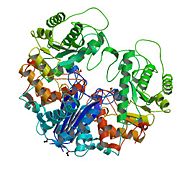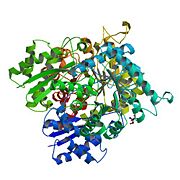Sandbox Reserved 455
From Proteopedia
(Difference between revisions)
| Line 8: | Line 8: | ||
==Introduction== | ==Introduction== | ||
| - | <Structure load='1te6' size='500' | + | <Structure load='1te6' size='500' fram</StructureSection>e='true' align='right' caption='RSCB-Protein Data Bank: Crystal Structure of Human Neuron Specific Enolase at 1.8 angstrom' scene='Insert optional scene name here' /> |
Neuron Specific Enolase (NSE) is one of the five isozymes (isoenzyme) of the [[glycolysis]] enzyme [[enolase]]. An enolase falls under the category of [[lyase]], which is an enzyme that catalyzes the breaking of various chemical bonds by means other than hydrolysis and oxidation, often forming a new double bond or a new ring structure.<ref name="enolase">http://en.wikipedia.org/wiki/Enolase</ref> It is also known as a metalloenzyme, which means it contains a metal ion bound to the protein with one labile coordination site.<ref>http://en.wikipedia.org/wiki/Metalloenzyme#Metalloenzymes</ref> Enolase is present in all tissues and organisms capable of glycolysis or fermentation. It is the ninth and penultimate step of glycolysis, converting 2-phosphoglycerate (2-PG) to phosphoenolpyruvate (PEP). <ref name="enolase" />[[Image:Lobster Enolase .jpg|left|thumb|'''Biological Assembly Image for 1PDY''' Lobster Enolase <ref>X-RAY STRUCTURE AND CATALYTIC MECHANISM OF LOBSTER ENOLASE: http://www.rcsb.org/pdb/explore/explore.do?structureId=1PDY</ref>]] | Neuron Specific Enolase (NSE) is one of the five isozymes (isoenzyme) of the [[glycolysis]] enzyme [[enolase]]. An enolase falls under the category of [[lyase]], which is an enzyme that catalyzes the breaking of various chemical bonds by means other than hydrolysis and oxidation, often forming a new double bond or a new ring structure.<ref name="enolase">http://en.wikipedia.org/wiki/Enolase</ref> It is also known as a metalloenzyme, which means it contains a metal ion bound to the protein with one labile coordination site.<ref>http://en.wikipedia.org/wiki/Metalloenzyme#Metalloenzymes</ref> Enolase is present in all tissues and organisms capable of glycolysis or fermentation. It is the ninth and penultimate step of glycolysis, converting 2-phosphoglycerate (2-PG) to phosphoenolpyruvate (PEP). <ref name="enolase" />[[Image:Lobster Enolase .jpg|left|thumb|'''Biological Assembly Image for 1PDY''' Lobster Enolase <ref>X-RAY STRUCTURE AND CATALYTIC MECHANISM OF LOBSTER ENOLASE: http://www.rcsb.org/pdb/explore/explore.do?structureId=1PDY</ref>]] | ||
Revision as of 15:10, 8 May 2012
| This Sandbox is Reserved from 13/03/2012, through 01/06/2012 for use in the course "Proteins and Molecular Mechanisms" taught by Robert B. Rose at the North Carolina State University, Raleigh, NC USA. This reservation includes Sandbox Reserved 451 through Sandbox Reserved 500. | ||||||||||||
To get started:
More help: Help:Editing For more help, look at this link: http://www.proteopedia.org/wiki/index.php/Help:Getting_Started_in_Proteopedia Neuron Specific Enolase (Enolase 2)Introduction
|
||||||||||||


